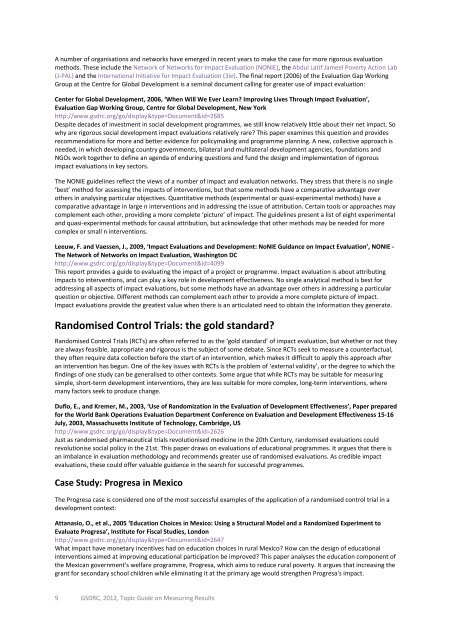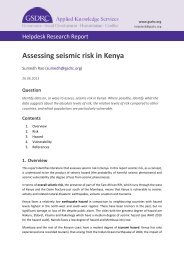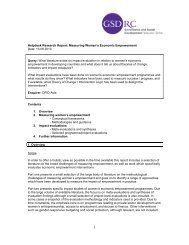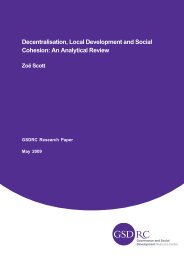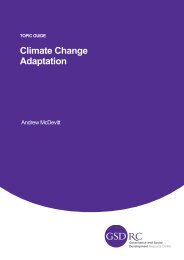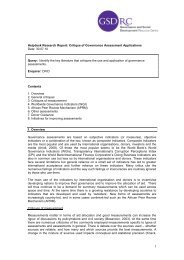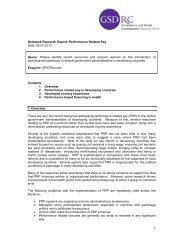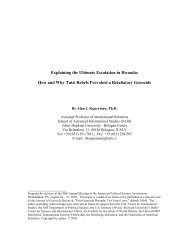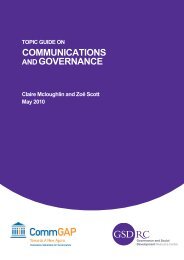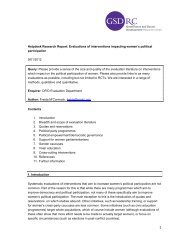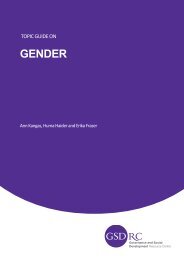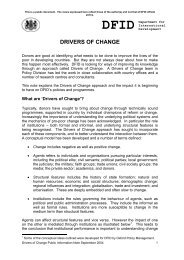PDF (28 pages; 360 KB) - GSDRC
PDF (28 pages; 360 KB) - GSDRC
PDF (28 pages; 360 KB) - GSDRC
You also want an ePaper? Increase the reach of your titles
YUMPU automatically turns print PDFs into web optimized ePapers that Google loves.
A number of organisations and networks have emerged in recent years to make the case for more rigorous evaluationmethods. These include the Network of Networks for Impact Evaluation (NONIE), the Abdul Latif Jameel Poverty Action Lab(J-PAL) and the International Initiative for Impact Evaluation (3ie). The final report (2006) of the Evaluation Gap WorkingGroup at the Centre for Global Development is a seminal document calling for greater use of impact evaluation:Center for Global Development, 2006, ‘When Will We Ever Learn? Improving Lives Through Impact Evaluation’,Evaluation Gap Working Group, Centre for Global Development, New Yorkhttp://www.gsdrc.org/go/display&type=Document&id=2685Despite decades of investment in social development programmes, we still know relatively little about their net impact. Sowhy are rigorous social development impact evaluations relatively rare? This paper examines this question and providesrecommendations for more and better evidence for policymaking and programme planning. A new, collective approach isneeded, in which developing country governments, bilateral and multilateral development agencies, foundations andNGOs work together to define an agenda of enduring questions and fund the design and implementation of rigorousimpact evaluations in key sectors.The NONIE guidelines reflect the views of a number of impact and evaluation networks. They stress that there is no single‘best’ method for assessing the impacts of interventions, but that some methods have a comparative advantage overothers in analysing particular objectives. Quantitative methods (experimental or quasi-experimental methods) have acomparative advantage in large n interventions and in addressing the issue of attribution. Certain tools or approaches maycomplement each other, providing a more complete ‘picture’ of impact. The guidelines present a list of eight experimentaland quasi-experimental methods for causal attribution, but acknowledge that other methods may be needed for morecomplex or small n interventions.Leeuw, F. and Vaessen, J., 2009, ‘Impact Evaluations and Development: NoNIE Guidance on Impact Evaluation’, NONIE -The Network of Networks on Impact Evaluation, Washington DChttp://www.gsdrc.org/go/display&type=Document&id=4099This report provides a guide to evaluating the impact of a project or programme. Impact evaluation is about attributingimpacts to interventions, and can play a key role in development effectiveness. No single analytical method is best foraddressing all aspects of impact evaluations, but some methods have an advantage over others in addressing a particularquestion or objective. Different methods can complement each other to provide a more complete picture of impact.Impact evaluations provide the greatest value when there is an articulated need to obtain the information they generate.Randomised Control Trials: the gold standard?Randomised Control Trials (RCTs) are often referred to as the ‘gold standard’ of impact evaluation, but whether or not theyare always feasible, appropriate and rigorous is the subject of some debate. Since RCTs seek to measure a counterfactual,they often require data collection before the start of an intervention, which makes it difficult to apply this approach afteran intervention has begun. One of the key issues with RCTs is the problem of ‘external validity’, or the degree to which thefindings of one study can be generalised to other contexts. Some argue that while RCTs may be suitable for measuringsimple, short-term development interventions, they are less suitable for more complex, long-term interventions, wheremany factors seek to produce change.Duflo, E., and Kremer, M., 2003, ‘Use of Randomization in the Evaluation of Development Effectiveness’, Paper preparedfor the World Bank Operations Evaluation Department Conference on Evaluation and Development Effectiveness 15-16July, 2003, Massachusetts Institute of Technology, Cambridge, UShttp://www.gsdrc.org/go/display&type=Document&id=2626Just as randomised pharmaceutical trials revolutionised medicine in the 20th Century, randomised evaluations couldrevolutionise social policy in the 21st. This paper draws on evaluations of educational programmes. It argues that there isan imbalance in evaluation methodology and recommends greater use of randomised evaluations. As credible impactevaluations, these could offer valuable guidance in the search for successful programmes.Case Study: Progresa in MexicoThe Progresa case is considered one of the most successful examples of the application of a randomised control trial in adevelopment context:Attanasio, O., et al., 2005 ‘Education Choices in Mexico: Using a Structural Model and a Randomized Experiment toEvaluate Progresa’, Institute for Fiscal Studies, Londonhttp://www.gsdrc.org/go/display&type=Document&id=2647What impact have monetary incentives had on education choices in rural Mexico? How can the design of educationalinterventions aimed at improving educational participation be improved? This paper analyses the education component ofthe Mexican government's welfare programme, Progresa, which aims to reduce rural poverty. It argues that increasing thegrant for secondary school children while eliminating it at the primary age would strengthen Progresa's impact.9 <strong>GSDRC</strong>, 2012, Topic Guide on Measuring Results


